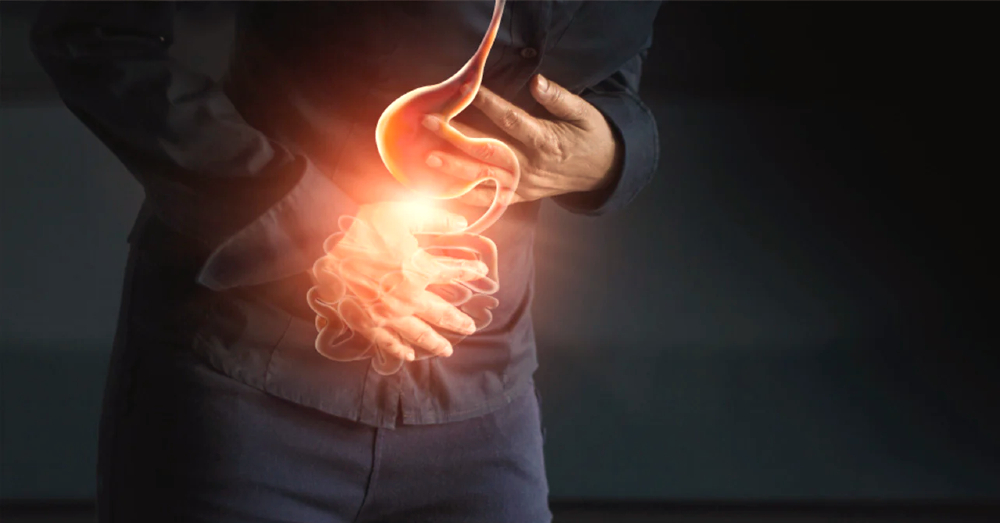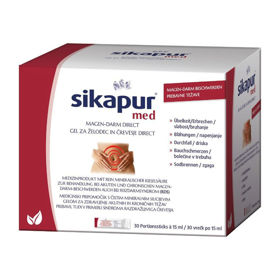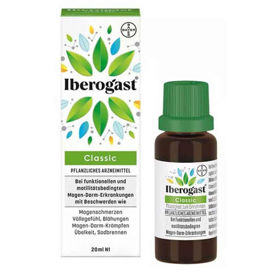A peptic ulcer is a well-circumscribed round or oval wound in the mucous membrane of the stomach or duodenum. It is caused by mucosa erosion caused by stomach acid and digestive juices. A shallow ulcer is called erosion.
ULCUS: General | Symptoms | Causes | Complications | Diagnosis | Treatment | Questions and Answers | Sources/references
Pepsin is an enzyme that, together with hydrochloric acid produced in the stomach lining, digests food, especially proteins. A peptic ulcer occurs on the mucous membrane of the gastrointestinal tract, where it is exposed to the action of acid and digestive enzymes-mainly in the stomach and duodenum. Ulcers are named after the place where they formed or the circumstances in which they formed.
The most common form of peptic ulcer is a duodenal ulcer. It forms in the duodenum, the beginning part of the small intestine, just below the stomach. Gastric ulcers are less common and usually occur at the upper curve of the stomach.
Image: Most ulcers can be healed without complications.

If part of the stomach has been surgically removed, an anastomotic ulcer may develop where the rest of the stomach was sutured to the small intestine. Repeated stomach acid leakage into the esophagus's lower part can cause inflammation (oesophagitis) and ulcers of the esophagus. Ulcers that develop due to stress, serious illness, burns, or injury are called stress ulcers.
Symptoms
It is characteristic that the ulcer likes to heal and repeat itself. Symptoms vary depending on the location of the ulcer and the patient's age. Symptoms may be unusual or absent in children or older people. In these cases, the ulcer is discovered only when complications arise.
Only about half of people with a duodenal ulcer have the typical symptoms: gnawing and burning pain, tenderness, feeling empty and hungry. The pain tends to occur on an empty stomach. Ulcers usually do not cause pain immediately in the morning, but they appear in the morning. The pain is constant, mild to moderate, usually limited to a specific area, almost always just below the sternum.
Video content: A surprising causative agent of stomach ulcers.

Drinking milk, eating food, or taking antacids usually relieves the pain, but it returns within two to three hours. Pain that wakes the patient at night, at one or two in the morning, is joint. Often, the pain breaks out once or several times a day, repeating for one to several weeks and then disappearing on its own.
The pain tends to recur in the first two years and occasionally even later. An individual usually has a specific pattern of pain recurrence, which can be predicted from experience when the problems reappear (usually in the spring and autumn and during stress).
Symptoms of a gastric ulcer often do not follow the same pattern as those of a duodenal ulcer; eating food does not relieve the pain but even triggers it. Stomach ulcers more often lead to swelling of the tissues of the small intestine, which hinders the movement of food from the stomach. This causes bloating, nausea, or vomiting after eating. In esophagitis or esophageal ulcers, the pain usually occurs while swallowing or lying down. Complications of a peptic ulcer, such as bleeding or perforation, cause more severe symptoms.
Causes
An ulcer develops when the defense mechanisms that protect the duodenum or stomach from the action of stomach acid fail - e.g., when the amount of mucus produced changes. We don't know why this happens.
Almost everyone makes stomach acid, but only one in ten people develops an ulcer. Different people make different amounts of stomach acid, and an individual's pattern of acid secretion tends to be constant throughout life. In fact, according to the amount of acid secretion, babies can already be divided into those who secrete a little, medium, or a lot of stomach acid.
Image: H. pylori bacteria were found in the stomach of people with duodenal ulcers.
.jpg)
The risk of developing a peptic ulcer is higher for those who secrete a lot of acid than for those who secrete a little. Nevertheless, it is eaten away but rarely develops in most people who secrete a lot of acid. However, it can sometimes appear in a person who secretes little acid. In addition to acid secretion, other factors are forming an ulcer.
Helicobacter pylori bacteria have been found in the stomach of many people with duodenal ulcers, and they are considered one of the leading causes of peptic ulcers. It is not yet entirely clear how these bacteria contribute to ulcer formation. They can interfere with the normal functioning of the stomach's defense mechanisms or produce a toxin that helps ulcer formation. Duodenal ulcers are rarely cancerous.
Gastric ulcers differ from duodenal ulcers in that they appear later in life. Some drugs, especially acetylsalicylic acid, ibuprofnonsteroidalr, and nonsteroidal antinonsteroidaly drugs, cause erosions and ulcers in the stomach, especially in older people.
Erosions and ulcers heal when a person stops taking these drugs and are reluctant to recur, except when the person starts taking said drugs again. Healing is also possible in some cancerous (malignant) gastric ulcers. Still, this fact makes it difficult to distinguish them from non-cancerous (benign) gastric ulcers, which are caused by, e.g., due to medication.
Complications of peptic ulcer
Most ulcers heal without complications. However, some can develop life-threatening conditions, such as penetration, perforation, bleeding, or obstruction.
Penetration
The ulcer can spread through the muscular wall of the stomach or duodenum and continue into an adjacent solid organ, e.g., the liver or pancreas. This causes intense, stabbing, constant pain the patient can feel outside the affected area. A duodenal ulcer penetrates the pancreas; the pain can, for example, appear in the back. When the body's position changes, the pain may increase. If the ulcers are not cured with medication, surgery is required.
Perforation
Ulcers of the front side of the duodenum or, less commonly, of the stomach can continue through the wall, opening the free abdominal cavity. The pain comes on suddenly and is severe and constant. It spreads rapidly throughout the abdominal cavity. The patient may feel pain in one or both shoulders, which strengthens during deep breathing. Changing the body's position usually greatly intensifies the pain, so the patient tries to lie entirely still.
Video content: How to overcome stomach ulcers.

The abdomen is sensitive to touch; the sensitivity increases when the doctor presses hard on the abdominal wall and then relieves the pressure ("sensitivity to pressure relief"). The symptoms are less pronounced in older adults, people treated with corticosteroids, and those very sick. Fever is a sign of abdominal infection. If this condition is not treated, shock can develop. Immediate surgery and intravenous antibiotics are required.
Bleeding
Bleeding is a common complication of ulcers, even those that do not hurt. Symptoms of bleeding ulcers may include vomiting bright red blood or reddish-brown clots, partially digested blood that looks like coffee grounds, and passing black or bloody stools. Such bleeding can also result from some other gastrointestinal disease, but doctors first try to rule out the source of bleeding in the stomach or duodenum.
Image: Treatment of the ulcer usually also resolves the blockage.
.jpg)
If the bleeding is not profuse, the doctor performs an endoscopy (examination with a flexible viewing tube). If a bleeding ulcer is visible, the endoscope can also be used for cauterization. When the source of the bleeding is not found, and the bleeding is not profuse, the ulcer is treated with drugs, e.g., with H2 antagonists and antacids. The patient is also replaced with fluids intravenously but does not consume anything; this is the only way the digestive system can rest. If the bleeding is persistent or profuse, the doctor may use an endoscope to inject a substance that causes the blood to clot. When this method is also unsuccessful, surgery is required.
Prison
Swelling inflamed tissue around an ulcer or scarring from a previous ulcer can narrow the exit from the stomach or duodenum. A person with such constipation often vomits and often regurgitates large amounts of food that he has eaten several hours before.
Common symptoms of constipation are feeling unusually full after eating, straining, and a lack of running. Over time, vomiting results in weight loss, dehydration, and an upset balance of body minerals. Treatment of the ulcer usually also resolves the obstruction; otherwise, endoscopic procedures or surgery are necessary.
Diagnosis
The doctor thinks of an ulcer when characteristic stomach pains occur. Certain tests are needed to confirm the diagnosis and exclude the possibility of stomach cancer, which can have similar symptoms. When ulcers do not respond to treatment, especially if they are severe or in unusual places, the doctor may also suspect other possible causes of excess stomach acid.
Endoscopy, barium X-ray, analysis of stomach contents, and blood tests can be used to diagnose ulcers. An endoscopy is an outpatient examination of the stomach with a long, flexible examination tube (endoscope) inserted through the mouth. It is the first diagnostic method since ulcers are usually clearly visible with an endoscope.
Endoscopy is more reliable than X-ray imaging for detecting ulcers on the duodenum and the back wall of the stomach; it is also more reliable in patients after gastric surgery. However, even a highly experienced endoscopist can miss 5 to 10 percent of duodenal and gastric ulcers.
Image: Antacids are available in tablets and liquids.
.jpg)
With the endoscope, they can also perform a biopsy (removing a tissue sample for examination) to determine the possible cancer of the ulcer. They can also stop ulcer bleeding with an endoscope. Barium radiography of the stomach and duodenum is useful when ulcers are not detected endoscopically. With this method, up to 20 percent of peptic ulcers are missed.
By analyzing the stomach contents, they measure the amount of secreted stomach acid by sucking the contents directly from the stomach and duodenum; it is performed only if the ulcer is extensive or recurrent and before surgery. Blood tests do not show an ulcer, but they can detect anemia due to a bleeding ulcer. Other blood tests show the presence of Helicobacter pylori bacteria.
Treatment
One treatment option for a duodenal or stomach ulcer is neutralizing or reducing stomach acid. This process begins with the removal of potential stomach irritnonsteroidals, nonsteroidal anti-inflammatory drugs, alcohol, and nicotine. A light diet may help treat ulcers, but there is no substantial evidence that it speeds up the healing process or prevents ulcer recurrence. Nevertheless, patients should avoid foods that make their pain and bloating worse.
Antacids
Antacids relieve symptoms, speed up healing, and reduce the frequency of ulcer recurrence. Most antacids can be purchased over the counter. An antacid's ability to neutralize stomach acid depends on the amount consumed and the individual, and in the same individual, the time at which it is taken. The patient's choice of antacid is influenced by several factors: the drug's taste, its effect on bowel movements, and its price and effectiveness.
Antacids are available in tablets and liquids. Tablets are more convenient but less effective than liquids. Antacids that are absorbed quickly and completely neutralize stomach acid. Sodium bicarbonate or calcium carbonate is the most potent antacids; patients can take them occasionally to relieve problems. Because they are absorbed into the blood, their frequent consumption can alter the acid-base balance of the blood, leading to alkalosis (milk-alkali syndrome). Therefore, one should not take these antacids in large quantities for more than a few days. Symptoms of alkalosis include nausea, headache, and weakness, but these symptoms can also be a sign of another disease.
Video content: 5 natural ways to treat stomach ulcers.

Non-absorbable antacids are preferred because they cause fewer side effects; in particular, they rarely cause alkalosis. They bind with stomach acid to form compounds that remain in the stomach, reducing the action of digestive juices and relieving ulcer symptoms without causing alkalosis. However, these drugs can interfere with the absorption of other drugs into the bloodstream (e.g., tetracyclines, digoxin, and iron).
Aluminum hydroxide is a relatively safe, commonly used antacid. However, aluminum can bind with phosphate in the gastrointestinal tract, reducing phosphate levels in the blood and causing loss of running and weakness. The risk of side effects is higher in alcoholics and kidney patients, including hemodialysis patients. Aluminum hydroxide can also cause burning.
Magnesium hydroxide is a more effective antacid than aluminum hydroxide. The stool remains regular, but only if we take only four doses of one to two large spoonfuls of the medicine daily; more than four such doses may cause diarrhea. Because small amounts of magnesium are absorbed into the bloodstream, people with kidney disease should only take this medicine in small doses. Many antacids contain both aluminum and magnesium hydroxide.
Antiulcer drugs
Ulcers are usually treated for at least six weeks with drugs that reduce acid secretion in the stomach and duodenum. Any anti-tuberculosis drug can neutralize or reduce stomach acid secretion and relieve symptoms within a few days. If the symptoms do not disappear entirely or if they recur when the patient stops taking the medicine, they usually need additional tests.
Sucralfate creates a protective layer at the bottom of the ulcer, thus speeding up its healing. It works well in peptic ulcers and is a suitable antacid substitute. Sucralfate is taken three to four times a day. The drug is not absorbed into the bloodstream, so there are few side effects (constipation sometimes occurs).
H2 antagonists (cimetidine, ranitidine, and famotidine) promote ulcer healing by reducing acid and digestive enzymes in the stomach and duodenum. These are very effective medications that can only be taken once or twice daily. For the most part, they cause few severe side effects. Cimetidine can cause reversible breast enlargement in men. Less commonly, cimetidine. In men who take large doses of this drug for a long time, it causes impotence.
Image: Ulcers are more common in people 60 or older, especially men.
.jpg)
Mental changes (especially in the elderly), diarrhea, rash, fever, and muscle pain have been reported in less than 1 percent of people treated with cimetidine. If any of the above problems occur in a person taking cimetidine, switching to another H2 antagonist is best. People who take cimetidine should always tell their doctor, as it affects the elimination of some other medicines from the body - e.g., theophylline (for asthma), warfarin (for blood clotting), and phenytoin (for seizures).
Omeprazole and lansoprazole are potent drugs that inhibit the production of enzymes necessary to produce stomach acid. They can completely suppress stomach acid secretion and have a long-lasting effect. They promote ulcer healing in a more significant percentage of people and in a shorter time than H2 antagonists. They are particularly effective in treating people with esophagitis with or without esophageal ulcers and people with other conditions that affect stomach acid secretion, e.g., Zollinger-Ellison syndrome.
Antibiotics are increasingly used for treatment when the leading cause of ulcers is Helicobacter pylori. Treatment consists of a combination of one or more antibiotics (most commonly amoxicillin and metronidazole) and an acid-suppressing drug (most commonly omeprazole). Such treatment alleviates the symptoms even if the previous treatment of the ulcer has been unsuccessful or if the ulcer has recurred several times.
Misoprostol is used to prevent ulcnonsteroidal no nonsteroidal nonsteroidal drugs. Doctorsnonsteroidalwholly united about all the indications for treatment with misoprostol. However, most agree that it can help some people with arthritis who take high doses of NSAIDs. Misoprostol is not given to all such patients, as it causes diarrhea in about 30 percent, and peptic ulcers occur in only 10 to 15 percent of people who take high doses of NSAIDs for arthritis.
Operation
Because drug treatment of ulcers is so effective, surgery is rarely necessary. They only decide on it in the case of peptic ulcer complications, e.g., in perforation, constipation that does not respond to treatment or recurs, in two or more severe recurrences of ulcer bleeding, in gastric ulcer suspected to be cancerous, or in severe and frequent recurrences of peptic ulcer.
Video Content: 10 Science-Based Home Remedies for Ulcers.

There are many different operations available to solve these problems. The ulcer can recur even after surgery, and any surgical intervention can lead to additional problems, e.g., weight loss, poor digestion, and anemia.
Questions and answers
Why does a stomach ulcer occur?
An ulcer develops when the defense mechanisms that protect the duodenum or stomach from the action of stomach acid fail - e.g., when the amount of mucus produced changes. We don't know why this happens. In many people with duodenal ulcers, Helicobacter pylori bacteria have been found in the stomach, and they are considered one of the leading causes of peptic ulcers.
Can stomach ulcers cause cancer?
Stomach ulcers are sometimes thought to cause cancer. H. pylori, a bacteria that causes ulcers, may be a factor that leads to stomach cancer[1]. Occasionally, stomach ulcers can become cancerous (stomach cancer). Vomiting blood, black stool, or blood in the stool can also be signs of stomach cancer and peptic ulcers. If you have these symptoms, call your doctor[2].
Who most often gets a stomach ulcer?
Gastric ulcers can affect anyone but are more common in people 60 or older, especially men[3].
What are the complications of an ulcer?
Most ulcers heal without complications. However, some can develop life-threatening conditions, such as penetration, perforation, bleeding, or obstruction.
Is the ulcer curable?
Most ulcers heal within a few months with treatment. If your stomach ulcer is caused by a bacterial infection with Helicobacter pylori (H. pylori), treatment with antibiotics and a medicine called a proton pump inhibitor (PPI)[3] is recommended.
Sources and references
- Stomach Cancer - https://www.cedars-sinai.org
- Stomach Cancer vs. Stomach Ulcers - https://www.emedicinehealth.com
- Stomach ulcer - https://www.nhs.uk










 Facebook
Facebook
 Instagram
Instagram
 info@moja-lekarna.com
info@moja-lekarna.com

